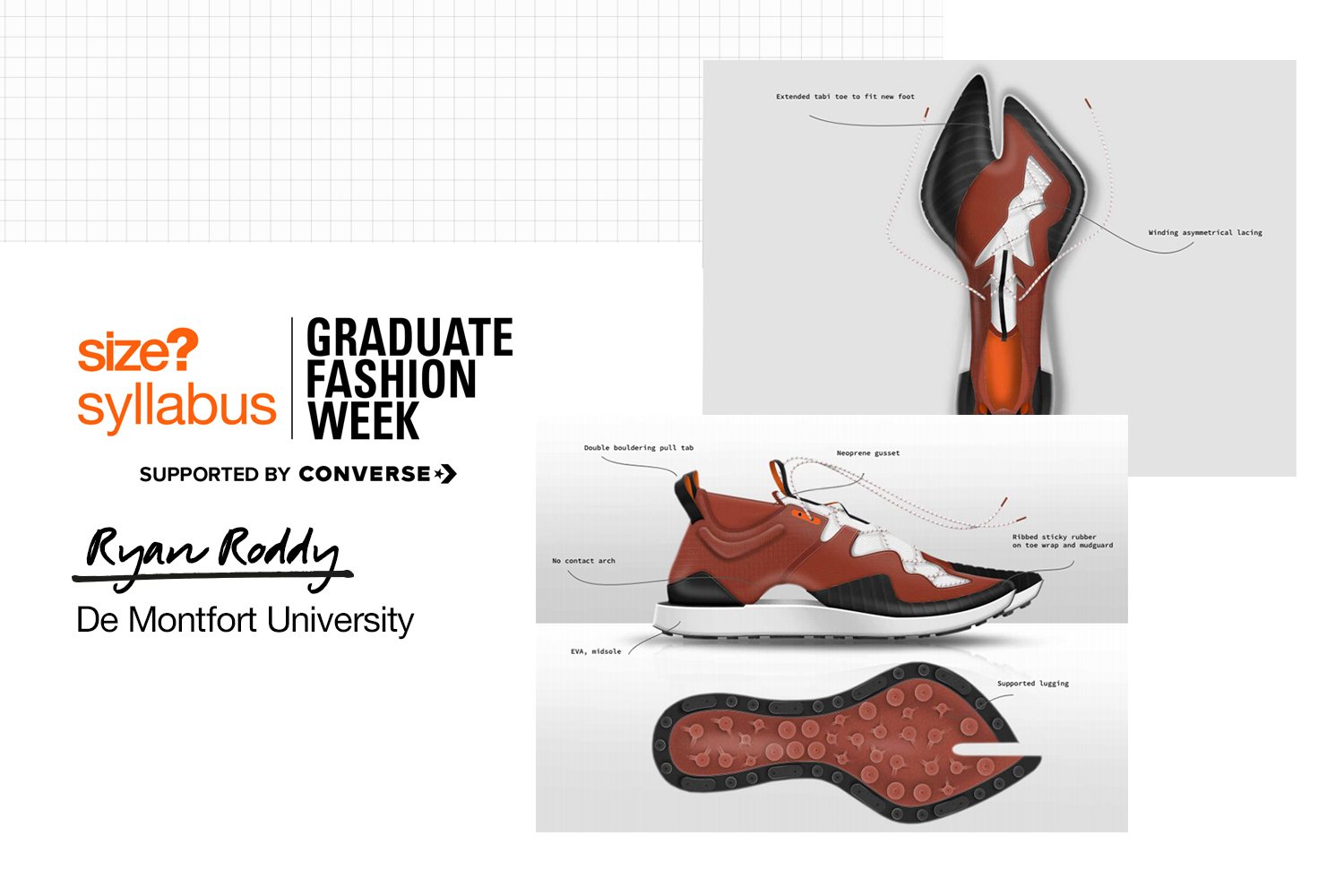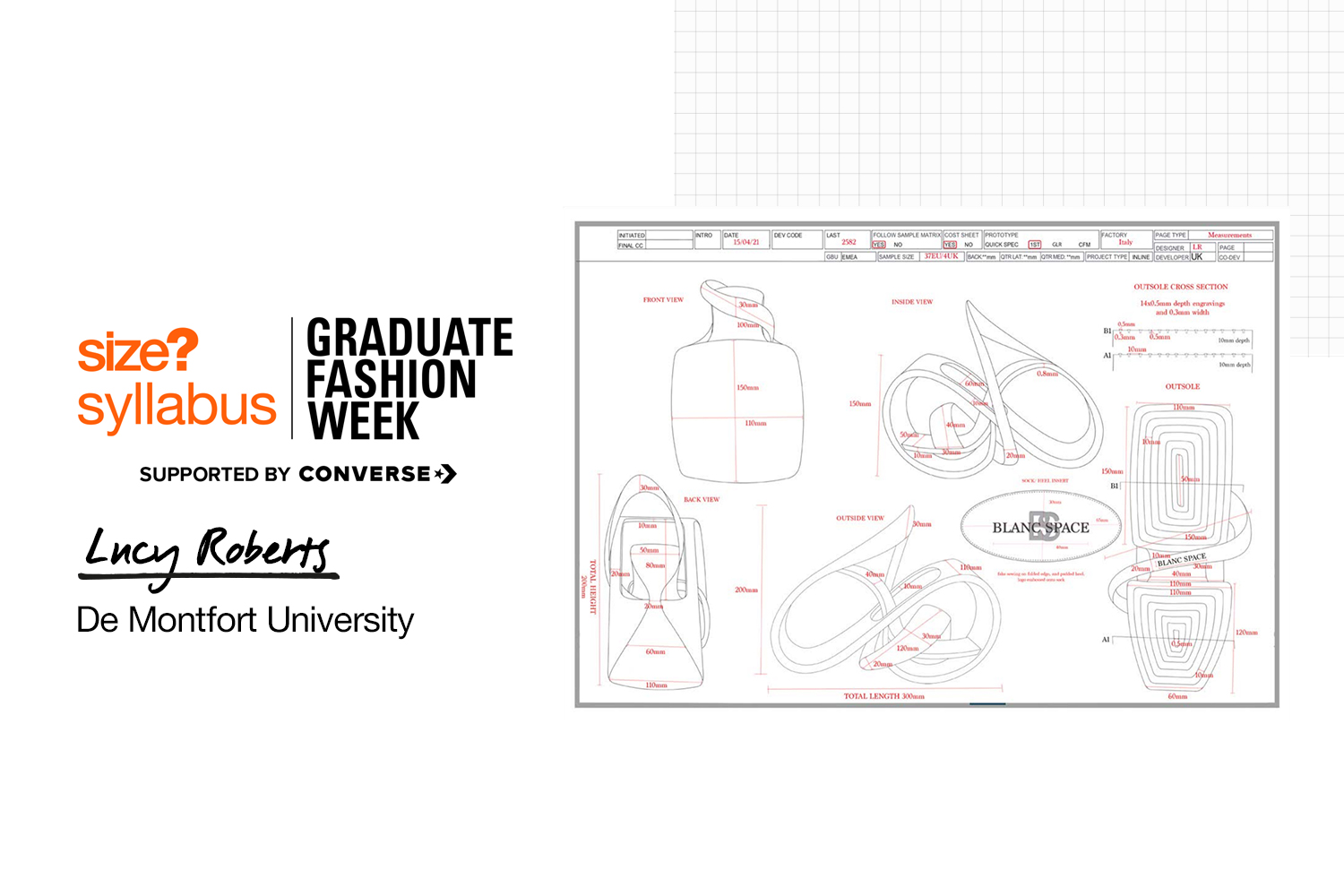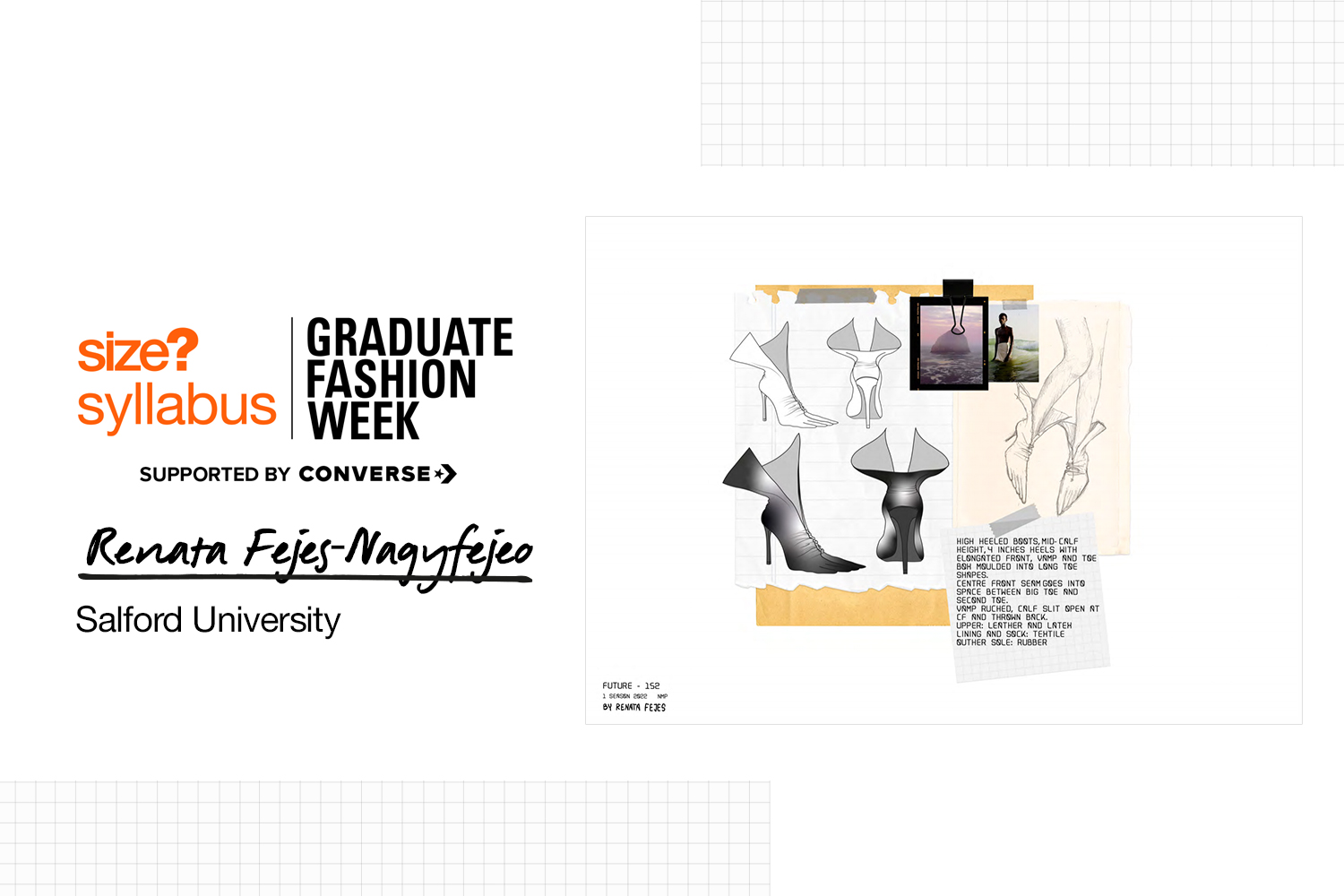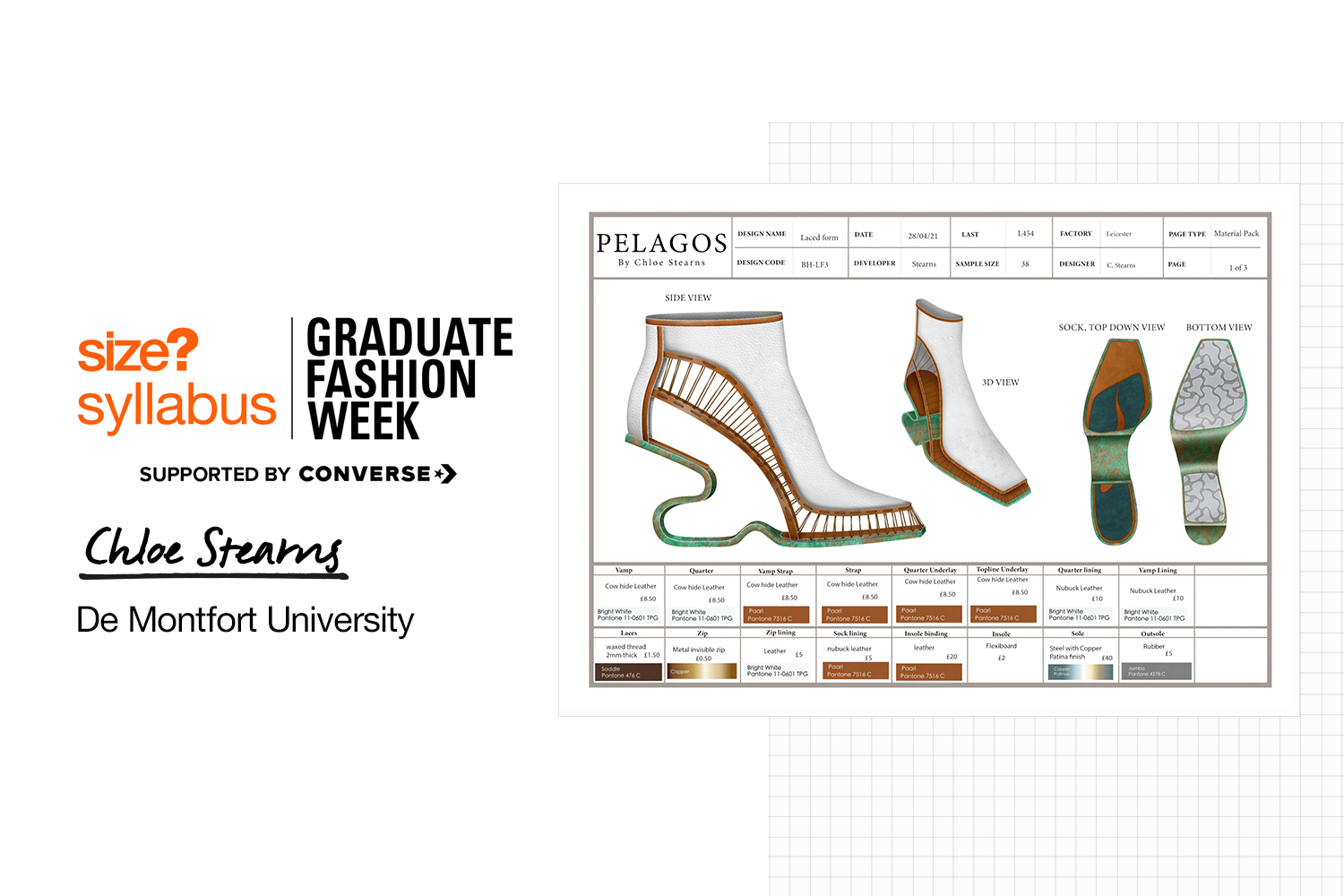Introducing our size? sponsored Footwear Award entries for Graduate Fashion Week 2021

Graduate Fashion Week is back again, and we are super excited to be there for a fourth year running. Taking place from the 12 June – 18th June, this year’s show will be a live-streamed event with runway shows, live talks, The GFW Showroom and much more.
Through our size? syllabus project, we’ll be collaborating with university fashion and creative departments to support and promote rising talent. What’s more, we are thrilled to be the official sponsor for the Footwear Design Award for a 2nd year running – and we can now reveal the shortlist for this award.

For this award, students will be creating their own unique and fashion-forward footwear concepts. This might include designs based on sculptures, sustainable innovations, high-end silhouettes, utility shoes and more!
The panel will have to pick a winner from 10 students from the shortlist, so before the week begins, we thought we’d introduce you to every candidate and their work – don’t miss out!
Jihee Ahn – Footwear Design – De Monfort University

For Jihee Ahn’s project, the link between car design and trainers was the main inspiration. From shapes to colourways and textures, automobile production methods are a major inspiration to many footwear brands.
Jihee explained: “In the footwear industry, imitating a sports car’s design has been evermore common. Footwear design has strong roots in sports cars. Notable brands, spinners made a great contribution to the popularity of cars and shoes by embodying ‘Bling Era’ in the hip hop genre.”
Jihee also elaborated on the design process – “3D printing has been recognised as the most innovative way for automobiles and is a useful method for many shoe manufacturers such as Nike and adidas.”
Ryan Roddy – Footwear Design – De Monfort University

Ryan’s design focuses on challenging the latest footwear trends, using the theory of evolution as an inspiration for the silhouette.
Ryan spoke a bit about his view on trends in footwear:
“The DNA of my project, like many others lays within trending footwear. However, instead of researching on WGSN and Instagram for hours to try and seek out what others are telling me is ‘popping’ and in ‘trend’ I aimed to challenge the world of trending footwear.”
This project looks to trends well in the future of time, observing how evolution might affect our footwear:
“ETS is not only a unique and innovative footwear proposition but it is a conceptual design formed from predictions, it’s my hypothesis to the people living in the year 8,021, it’s the foot reincarnated… and it’s so ahead of the curve that your feet don’t even fit it yet. I think that ETS surpasses answering the brief as it does not only demonstrate distinctive detailing, a new approach, research and design development.”
Lucy Roberts – Footwear Design – De Montfort University

Lucy Roberts is a third-year Footwear Design Undergraduate who has a passion for creating innovative footwear concepts. For this project, Lucy took design cues from sculptural pieces of art: “For this project, I wanted to produce a new, innovative approach to footwear design. I aimed to create expressive, sculptural, high-end women’s dress shoes that push the boundaries of conventional, stereotypical footwear.”
She gave us an insight into the design process: “Each individual design was developed from different Mariko Mori sculptures, which I used as inspiration for my initial sketches. I further refined these to produce captivating shoe designs.”
Jeaeun You – Footwear Design – De Montfort University

Jeaeun You’s high-end footwear collection uses high-quality leather, and the designs are inspired by lizard shedding and autotomy. Used as a self-defence mechanism, or a distraction, this natural process replicated in the designs.
Jeaeun shed light on her idea of linking boots to mules, “The Tail of the cylindrical boots and the zip combine with the tail which is grown-up new. The final design is a modular shoe with a zipper on the back and a snap button on the front.”
The outsole also nods to lizards and their movements, “The reason for using the Oversole is that it can show not only the way lizards walk but also the shape of the bottom of their feet.”
Poppy Vrayer Griffiths – BA (Hons) Fashion – Northumbria University Graduate

For Poppy’s project, she was inspired by a parachute dress from World War 2 that she received as a gift. This inspiration allowed her to create something functional and fused historical military garments with contemporary fashion.
“My research into the military parachute took me down so many interesting routes. I was able to visit the Eden Camp Military Museum, in Yorkshire, where I discovered the Franks Anti Blackout Suit. The Anti-Blackout Suit was a garment worn by pilots to protect them from the side effects of G-force.”
“This collection of footwear will use the functional aspect of the Anti-Blackout Suit to create stiletto-heeled boots and trousers that push the boundaries between shoes and garments whilst giving the wearer optimal comfort.”
Sustainability was also crucial to the design, “I have worked to make sustainable practices very natural in my approach to design so, for instance, the fabrics I sourced in my final collection come from deadstock companies, I also used Econyl, TENCEL, and GOTS-certified fabrics.”
Renata Fejes-Nagyfejeo – BA (Hons) Fashion Design – Salford University

Renata Fejes-Nagyfejeo’s work is based on her own created narrative, where the year is 152 after global extinction due to a nuclear war. The project focuses on another chance for mankind to better themselves with a new system with improved ethics.
“I speculated their beliefs and behaviours, as well as the otherworldly landscapes and distorted living conditions that command new ways of existing”
Renata explained how this was shown on her shoe designs, “I worked with modelling clay first to create shapes I could then cover with latex. Next, I scanned in my own foot and manipulated it in ZBrush to achieve the exact desired shape, which after was 3D printed and covered in latex.”
It all came together for the final design, creating a “high heeled boot with ruched vamp and a toe shaped front. The calf is recycled leather, seamlessly blended with the latex toe box. The flexible material didn’t need a fastening, so the centre front is just slit open.”
Hye Jin Kim – Footwear Design Course – De Montfort University

This design focuses on Hye Jin Kim’s Korean heritage and the Korean eco-friendly fashion brand Danha. Inspired by the work and creativity of Sophia Webster, Renata decided to focus on footwear design as a career to express their creativity.
She shed light on her design inspiration here, “The inspiration for Hanbok comes from my background. As a Korean that grew up in China, Hanbok always represented me, my country, it became a symbol of who I am. I have never been taught in Korean education – this project helped me to research and dig depth for Korean culture.”
“This project is formed with 3 categories. Activity, style and technology, I have chosen Rodeo as activity, catwalk as style and morphing as technology. To design, I must think about all elements and how those will interpret the technology in all footwear. I researched some Rodeo related catwalk shoes for design trends and colours that are related to a theme or commonly seen in activity.”
Chloe Stearns – Footwear Design BA (Hons) – De Monfort University

Taking design cues from the sculptures of Barbara Hepworth, Chloe wanted to create something minimalist, whilst also making a firm statement. Also, luxury womenswear was a major influence on this creation.
Chloe described Laced Form as a:
“mid-height open boot with laced detail along the upper. The curvatures within the shoe mimic the organic shapes within Barbara Hepworth’s sculptures and the open space that is created by the split insole and the windows in the insole recreate the negative space that is a prominent feature in her work.”
“The all-leather upper is a statement too with the laces forming around the toes and up towards and over the ankle bone. The lace system is set so it functions as if it is its own full piece of material, rather than being functional, just like the wiring Hepworth uses in her sculptures.”
Charlie Irwin – BA Footwear & Accessories – University of Northampton

Third-year student Charlie Irwin’s work is titled ‘Space’, and it explores the concept of helping customers get outdoors to escape their busy modern lives. This will be conducted with impact and waste in mind, made possible through re-purposing damaged and abandoned items.
Inspired by sustainability, Charlie’s project notices the problem of single-use camping gear, offering a solution to re-using the materials:
“Collaborating with National Clean Up teams – whose aim it is to keep our green spaces safe and tidy – Space brand aims to utilise second-hand materials found at these locations, such as tents, sleeping bags, scuba and climbing gear and much more”
The aim? “This gives these materials (that tend to be man-made, such as neoprene and nylon) a new purpose, extending their life, as well as postponing their trip to landfill.”
Jennifer Bradley – BA Footwear & Accessories – University of Northampton

This project focuses on sustainability, focusing on making a vibrant collection of eco-friendly, genderless shoes for children.
“Using a combination of photography by Frans Lanting and inspiration from children’s illustrators, like Axel Scheffler, I created my own illustrations That became fun appliqued characters for the shoes.”
Jennifer covered the differences in creating children’s shoes:
“In addition to this I contacted children’s footwear companies, like Start-rite, to learn the importance of growing room around the toe and the element of comfort to support the foot. The ideal consumers would be aged 3-7 years old, to wear for leisure activities”
The final shoe uses the Chelsea Boot silhouette:
“This shoe can be pulled on by the child giving them independence and interaction. The opening was inspired by the movement of fins by freshwater stingrays that live in the amazon rainforest rivers. Most stingrays have eyes that blend into their bodies by their marking, but I wanted mine to stand out to be unusual and striking.”







